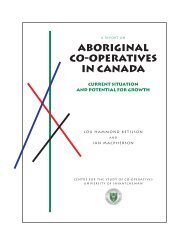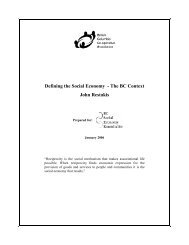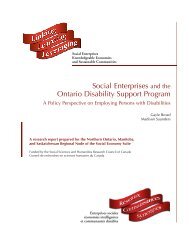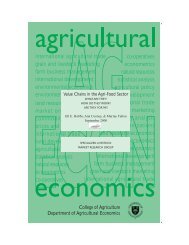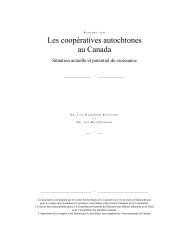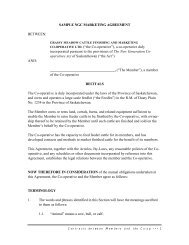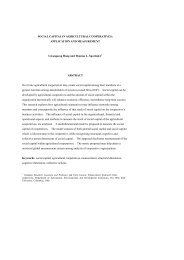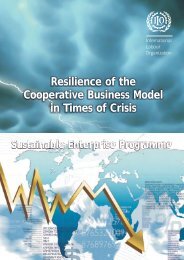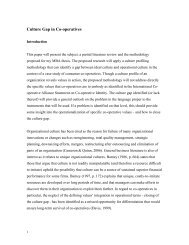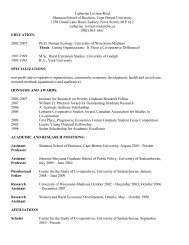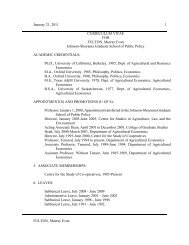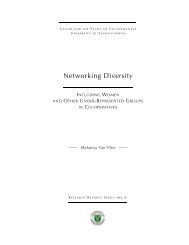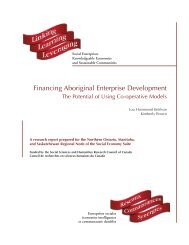Co-op College History - Centre for the Study of Co-operatives
Co-op College History - Centre for the Study of Co-operatives
Co-op College History - Centre for the Study of Co-operatives
You also want an ePaper? Increase the reach of your titles
YUMPU automatically turns print PDFs into web optimized ePapers that Google loves.
10 CREWE<br />
ety <strong>of</strong> speakers from <strong>the</strong> local FCL branch helped provide instruction in co-<strong>op</strong> management<br />
<strong>the</strong>ory. Worksh<strong>op</strong>s gave students an <strong>op</strong>portunity to tackle relevant issues relating to <strong>the</strong>ir<br />
own co-<strong>op</strong> such as networking, co-<strong>op</strong>s in <strong>the</strong> community, public relations in <strong>the</strong> local co-<strong>op</strong>,<br />
accounts receivable, and <strong>the</strong> manager’s report to <strong>the</strong> board. The classroom also provided an<br />
<strong>op</strong>portunity <strong>for</strong> participants to practice public speaking. 25<br />
In June <strong>of</strong> 1957, twenty-four branch managers and employees from co-<strong>op</strong> life, fire, and<br />
casualty insurance companies across Canada attended a <strong>Co</strong>-<strong>op</strong> Insurance Leadership course<br />
in Fort Qu’appelle. Their instructors were experts in <strong>the</strong>ir field in <strong>the</strong> co-<strong>op</strong> sector. Barney<br />
Arnason discussed <strong>the</strong> economic basis <strong>for</strong> <strong>the</strong> co-<strong>op</strong>erative movement; O.M. McCreary,<br />
human relations and study groups; Harry Fowler, consumer co-<strong>op</strong>eratives; R.L. Stutt, marketing<br />
co-<strong>op</strong>eratives; A.C. MacLean spoke on credit unions; B. Johnson, on <strong>the</strong> co-<strong>op</strong>erative<br />
credit society; and Harold Chapman answered <strong>the</strong> question, what is a co-<strong>op</strong>erative? 26<br />
New instructors were recruited as <strong>the</strong> number and variety <strong>of</strong> courses increased. In April<br />
<strong>of</strong> 1957, Phil Ro<strong>the</strong>ry was hired as <strong>the</strong> institute’s first educational assistant. He had been <strong>the</strong><br />
District 7 field representative <strong>for</strong> <strong>the</strong> Saskatchewan Wheat Pool, previously finishing his master’s<br />
degree in agriculture at <strong>the</strong> University <strong>of</strong> Saskatchewan. 27 In 1959, <strong>the</strong> permanent staff<br />
expanded to three with <strong>the</strong> addition <strong>of</strong> Jake Fehr, whose invaluable experience with <strong>the</strong> early<br />
stages <strong>of</strong> <strong>the</strong> ICI in Manitoba was an obvious asset to <strong>the</strong> <strong>Co</strong>-<strong>op</strong> Institute. 28 Be<strong>for</strong>e he joined<br />
<strong>the</strong> staff, Fehr, who had a BSc in agriculture from <strong>the</strong> University <strong>of</strong> Manitoba, was <strong>the</strong> educational<br />
director <strong>of</strong> <strong>the</strong> Federation <strong>of</strong> Sou<strong>the</strong>rn Manitoba <strong>Co</strong>-<strong>op</strong>eratives. 29 With Anne<br />
Ewanchyna filling <strong>the</strong> vital position <strong>of</strong> secretary, <strong>the</strong> institute’s administration finally began<br />
to take shape.<br />
In those early years, <strong>op</strong>erations continued to evolve in a number <strong>of</strong> areas. As membership<br />
at <strong>the</strong> institute increased, <strong>the</strong> board organized committees to assist with course planning. A<br />
sponsorship programme was introduced to cover student fees. Between 1955 and 1957, <strong>the</strong><br />
location <strong>of</strong> <strong>the</strong> classroom moved from FCL’s home <strong>of</strong>fice on Avenue D to <strong>the</strong> fourth floor <strong>of</strong><br />
<strong>the</strong> Grain Building, and <strong>the</strong>n in 1959, to a classroom and administration area on <strong>the</strong> second<br />
floor <strong>of</strong> <strong>the</strong> Avenue Building.<br />
Despite <strong>the</strong> fluctuations in surroundings, <strong>the</strong> institute continued to <strong>of</strong>fer courses in lumber,<br />
insurance, and co-<strong>op</strong> management training. By <strong>the</strong> end <strong>of</strong> <strong>the</strong> 1958–59 season, more<br />
than 550 students had attended <strong>the</strong> institute, although <strong>the</strong> majority were still from FCL.<br />
While co-<strong>op</strong> <strong>the</strong>ory was included in <strong>the</strong>se courses, <strong>the</strong> content ultimately reflected more emphasis<br />
on <strong>the</strong> practical training <strong>of</strong> business employees. It would be a recurrent challenge<br />
throughout <strong>the</strong> history <strong>of</strong> <strong>the</strong> college to maintain this pioneering approach to adult-education<br />
while integrating <strong>the</strong>ory, history, and philos<strong>op</strong>hy alongside <strong>the</strong> technical in<strong>for</strong>mation.<br />
C ENTRE FOR THE S TUDY OF C O - OPERATIVES




